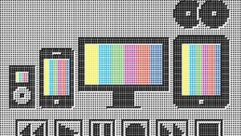A LOOK AT what schemes may come
Apr 1, 2000 12:00 PM,
Peter H. Putman
Sometimes, one can get so busy that he loses track of time. Such was thecase for the turn of the new year, which just flew by here. I hadoriginally intended to write this column for the January 2000 issue, butbetter late than never.
Over the past few years, I have written about a variety of display andinterfacing technologies. Now, I would like to have some fun and make a fewpredictions about where the various display and interfacing markets areheaded – what trends you will see, what products to look for, and whatpitfalls lie ahead.
Projectors
Of the changes that have occurred in the installation marketplace, none hasbeen as overwhelming as the flood of flat-matrix display technologies -transmissive LCDs, reflective LCDs, digital light processing and plasmadisplay panels. These new imaging technologies have simply surpassed suchestablished products as CRT projectors and CRT-engined videowalls.
The flood is only going to continue. Many desktop LCD projectors havebecome so powerful and feature-rich that they are being specified forinstallations in all kinds of public and private venues. It is easy to seewhy – you can take your pick of 12 pound to 18 pound (5.4 kg to 8.1 kg),1,000 lumen boxes that feature XGA (1,024 768) resolution, digital keystonecorrection, intelligent video/RGB scaling and support for component videoformats like YCbCr and YPbPr. Some models now support SXGA resolution, andI just tested an Epson unit that does a good job handling a variety ofsignal formats, including esoteric ones like 720p and 1,080i HDTV and 1,6001,200 workstation graphics.
There are also other XGA desktop models that can crank out the lumens. Allthree are rated at 2,000 ANSI, which, to put things in perspective, isabout 10 as bright as the typical 8 inch (203 mm) CRT projector of twoyears ago. These models are becoming the projectors of choice forconference room and classroom installations. Unless the customer has aspecific request for CRT imaging, LCDs are ruling the roost.
The emphasis on weight loss has also been evident with digital lightprocessing (DLP) technology. These offerings resemble CRT projectors insize and weight only. In addition to high-quality image scaling and 3:2pulldown detection, these three-chip DLP designs are rated in the 4,000lumen to 5,000 lumen range. That is more than enough brightness for theaverage conference room and boardroom installations, probably five timesmore.
The DLP imaging engines, however, will have to get smaller still if theyare to keep up with advances in LCD imaging. I have already seen at leastone ultra-portable LCD projector installed in a small conference room. Howlong before the portable and desktop categories simply merge, and we get ado-it-all XGA-resolution projector weighing 10 pounds (4.5 kg)with 2,000ANSI lumens?
Look for manufacturers to consolidate their lines somewhat, offeringultra-small, ultra-light projectors for portable use and installationmodels in the 8 pound to 12 pound (3.6 kg to 5.4 kg) range. Look, in turn,for the current 25 pound to 50 pound (11 kg to 23 kg) installationprojectors to shed more weight as they cannibalize the market dominated by100 pound (45 kg) large-venue machines.
The resolution wars will continue. We will probably see 1,600 1,200transmissive LCD imaging later this year from either Sony or Epson. Therehave been rumors that Texas Instruments may show a 1,920 1,080 DMD chip,but that would likely be a prototype. What you will see is ahigher-resolution D-ILA (Digital Image Light Amplifier) panel from JVC with2,048 1,536 pixels for high-brightness, high-resolution installationprojectors.
Because its recent consolidation of the Hughes-JVC operations, JVC hasbrought a few interesting products to market but none as interesting as theD’Ahlia home theater rear-projection TV. The imaging device is a single 1.5inch (38 mm) reflective D-ILA with color filters imbedded in its surfaceand a pixel resolution of 1,280 1,028 (non-square).
The significance of the D-Ahlia is that it eliminates color wheels andthree-panel RGB color imaging. That, in turn, translates into a compactlight engine with no moving parts, only a cooling fan. I predict that JVCwill bring out both an ultraportable and a compact installation projectorusing this self-contained holographic D-ILA sometime this year. You can besure that other manufacturers will want to private-label it.
Interfacing
With the advent of HDTV, it is no longer a question of whether a givenprojector or monitor supports component video formats; it must. Almostevery new projector or monitor I test is compatible with at least one ormore of the new DTV formats, including 480p, 720p and 1,080i.
The booming DVD marketplace has also had an impact because most newprojectors and monitors also support the YCbCr component format. Many ofthese displays are equipped with both 15-pin VGA-style jacks and 5 BNCjacks, and a few are ready to support digital formats like PanelLink, SDI,HD SDI and FireWire (IEEE 1394). Such a development has translated intohigher picture scan rates, which has forced a demand for better imagescaling. There has still been a monkey wrench thrown in the works – signalformat compatibility problems.
At least one current-model 42 inch (1.1 m) plasma panel will not correctlyrecognize a decoded, analog 720p or 1,080i HD signal in the RGBS/RGBHVformat. Several LCD projectors also fall into this trap, interpreting anyRGBS/RGBHV input strictly as a 4:3 computer image. That is a directinfluence of the Asian consumer marketplace. Although this means morebusiness for such companies as Extron, InLine and Altinex, it presents amajor pain in the neck for systems integrators.
On the other hand, help is on the way. Look for more and more products toadopt one of the pure digital interfaces, which means fewer connectors andfewer problems with standards.
As HDTV expands its reach, decoders will come to market with SDI output (asingle BNC jack carries all data), simplifying cable runs. You will not seea mass shift to pure digital video/computer interfaces this year, but youwill see a slow movement in that direction. Look for combinationserial/analog interfaces to start coming to market this year.
Also, keep your eyes out for an avalanche of video scalars as linemultipliers slowly fade away. Flat-matrix devices have their own uniquesignal and sync requirements, which are rarely satisfied by simpleline-multiplying. There will be an increased demand for glitch-freeswitching between RGB and video signal sources on installation projectorsand monitors, a task that only video scalars can pull off.
Prices will continue to drop on scalars, just as they did with linedoublers. Expect to see half a dozen new models at INFOCOMM this year withall of them capable of supporting every possible video, plasma, computerand HD format.
Monitors
If you think the projector market has been turned upside-down, wait untilyou see what is coming for monitors. Major manufacturers have been gearingup plants in Asia for the past two years to produce both large-screen LCDdisplays (25 inches or 635 mm and larger) and plasma displays (25 inches to50 inches or 635 mm to 1.3 m). CRTs are rapidly falling from grace as NEC,Mitsubishi, Pioneer, Fujitsu, Sharp, Philips, LG and Samsung are goingthin, and their targets are not only the traditional multimedia monitormarket, but also the consumer TV market.
Prices are still high, but they are going to drop faster than you mightthink. It was not too many years ago that a 10 inch (254 mm) 640 480 LCDmonitor would cost about $7,000. Now, you can buy 20 inch (508 mm) modelswith XGA resolution for less than half that amount, and they aredigital-ready. Early plasma monitors were retailing for more than $15,000;now, there are 42 inch (1.1 m) models for less than $10,000.
The interesting battle will be between TFT LCD and gas-plasma paneltechnology in the 25 inch to 32 inch (635 mm to 813 mm) market. Both arecapable of producing bright, contrast-rich images under normal roomlighting, and neither requires much of a footprint. Which will be thepeople’s choice? Again, outboard scalars will save the day with the displayof analog video sources, but the direct digital inputs will handleeverything else, including DTV/HDTV.
Look for several new large video/data monitors to be introduced in thecoming year with XGA and SXGA resolution. There will be a pile of plasmapanels to sort through as well; look for big improvements in video scalingand expanded (10-bit and maybe even 12-bit) digital signal sampling, twobig problems with previous plasma offerings.
Rear-projection monitors are not immune to the LCD/DLP onslaught. If youattend the INFOCOMM Projection Shoot-Out this year in Anaheim, CA, myprediction is that a majority of the monitors shown will use some sort offlat-matrix imaging, and many of them will be equipped with single-chip DLPand three-panel LCD engines.
The videowall market continues to move slowly away from CRTs withsingle-chip DMDs being the hot imaging engine. You will see more this year,and there may be a single-chip 1,280 1,024 DLP model exhibited at INFOCOMM.TFT LCDs are not as strong in this market as DMD chips, and that isunlikely to change soon.
Miscellany
Although tube-based technology is taking a back seat, other innovations arenot. There is plenty of interest in laser imaging with at least one companyhaving developed a laser-driven CRT capable of several thousand lumens -think of a 9 inch (229 mm) three-gun CRT chassis on steroids. Lasers arestill problematic, but they hold a great deal of promise for large-venueapplications because they have tremendous depth of field and do not requirelenses.
Silicon Light Machine’s grating light valve is also a technology to watch.This pixel-less light shutter can support infinite resolutions and has beentested with 2,000 and higher resolution. It is not likely to appear in theShoot-Out, but watch for announcements and demos over the coming year.
One of the smallest imaging components, the lowly LED, is making a realimpact in the large-venue display area. Stadiums, arenas, malls and otherlarge public venues are putting in high-brightness displays with millionsof LEDs as the pixel-forming elements. Sony and SACO Smartvision are activein this area, and are targeting older technologies like Jumbotron andvideowalls.
Finally, expect more crossover between products for the consumer andprofessional A-V markets. Single-chip DLP and three-chip SVGA LCDprojectors are already being offered to consumers for home theater andpersonal data projection.
That is enough forecasting. Better shut off my single-panel, 2,356 1,428pixel holographic, 12-bit grating crystal ball and get back to work.









